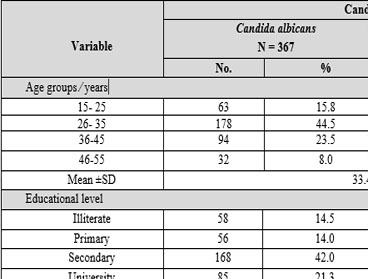Vulvovaginal candidiasis clinical signs, and distribution of Candida species
Main Article Content
Abstract
Background: Vulvovaginal candidiasis is a global issue of concern due to its association with economic costs, sexually transmitted infections, and ascending genital tract infection. The aim of this study was to determine clinical signs and species distribution of Candida species causing vulvovaginal candidiasis.
Methods: A cross-sectional study was conducted from December to June 2021-2024 among 400 women attending Obstetrics and Gynecology outpatient clinics in Sana'a City. The study involved collecting vaginal swabs from each participant and analyzing them in a microbiology laboratory. The swabs were used to identify yeast cells, fungal culturing, and germ tube formation tests. The study also used the VITEK II system to confirm species identification, with the VITEK® 2 YST ID identification card being used to identify Candida species.
Results: A study of 400 women found that 91.8% were infected with Candida albicans, while 8.2% were infected with other non-Candida albicans. The majority were aged 26-35, with secondary education being the most common. Most were married, with 1-3 pregnancies. The most common sign distribution was vaginal discharge with a 99.5% prevalence. Dysuria was the lowest, with a 65.0% prevalence. Candida species were most frequently isolated, with Candida albicans being the most common. Candida tropicalis was found in 1 out of 6 women, while Candida dubliniensis, Candida famata, Candida glabrata, and Candida lusitaniae were found in 1 out of 6 women.
Conclusions: The high prevalence rate of vulvovaginal candidiasis and observation of a low prevalence rate of nonalbicans Candida species in the present study substantiate the importance of conducting continuous epidemiological surveys to measure changes in species distribution from C. albicans to non-albicans Candida species in Yemen.
Downloads
Article Details

This work is licensed under a Creative Commons Attribution-NonCommercial-NoDerivatives 4.0 International License.

